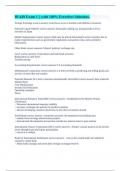Samenvatting
Samenvatting linguistics 3 stof FLOT Engels
Dit is een samenvatting van (bijna) het gehele boek van George Yule, The Study Of Language, dat wordt gebruikt voor het vak Linguistics / Taalkunde 3 op de lerarenopleiding Engels aan de Fontys in Tilburg. De samenvatting is uitgebreid, incl. begrippen, afbeeldingen en voorbeelden.
[Meer zien]









